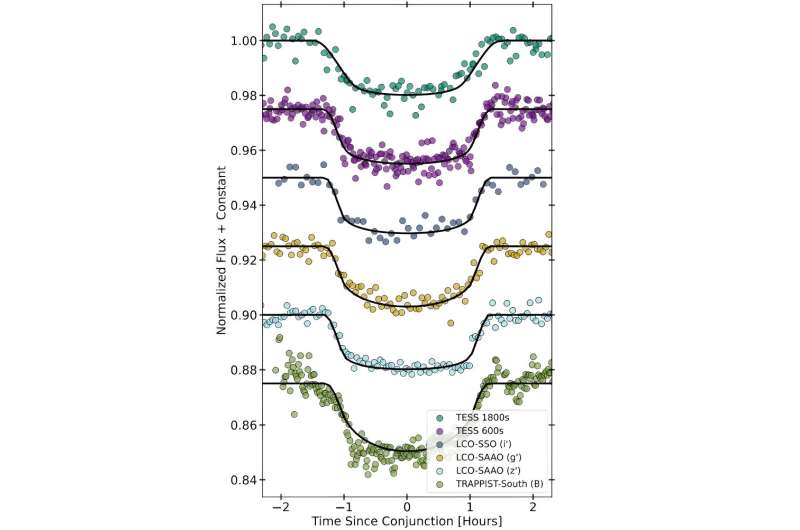January 17, 2024 report
This article has been reviewed according to Science X's and . have highlighted the following attributes while ensuring the content's credibility:
fact-checked
preprint
trusted source
proofread
TESS discovers nine new 'hot Jupiters'

Using NASA's Transiting Exoplanet Survey Satellite (TESS), an international team of astronomers has discovered nine new "hot Jupiter" exoplanets. One of the newly detected alien worlds is almost four times more massive than Jupiter. The finding was presented in a paper January 11 on the pre-print server arXiv.
TESS is conducting a survey of about 200,000 of the brightest stars near the sun with the aim of searching for transiting exoplanets—ranging from small, rocky worlds to gaseous giants. So far, it has identified over 7,000 candidate exoplanets (TESS Objects of Interest, or TOI), of which 415 have been confirmed.
Now, a group of astronomers led by Jack Schulte of the Michigan State University confirmed another nine planets monitored by TESS. They report that transit signals have been detected in the light curves of nine distant stars. The planetary nature of these signals was confirmed later by ground-based imaging and spectroscopic observations.
"In this article, we present nine new hot Jupiters discovered by NASA's TESS mission as part of an ongoing effort to discover and characterize all HJs [hot Jupiters] orbiting FGK stars brighter than G = 12.5 mag," the researchers wrote.
The newfound exoplanets, designated TOI-1855 b, TOI-2107 b, TOI-2368 b, TOI-3321 b, TOI-3894 b, TOI-3919 b, TOI-4153 b, TOI-5232 b, and TOI-5301 b, are mostly similar in size to Jupiter, but their masses range from 0.55 to 3.88 Jupiter masses. TOI-3919 b is the most massive one, while the largest one is TOI-1855 b—with a radius of approximately 1.65 Jupiter radii.
All the newly discovered planets have orbital periods shorter than eight days, and their equilibrium temperatures were estimated to be between 1,000 and 1,772 K. The hottest exoplanet out of the nine turned out to be TOI-5232 K.
The properties of these extrasolar worlds allowed the team to classify them as hot Jupiters. Such planets are similar in characteristics to Jupiter, while their orbital periods are less than 10 days. They have high surface temperatures, as they orbit their parent stars very closely.
It was noted that TOI-3919 b and TOI-5301 b have significant orbital eccentricities—at a level of 0.26 and 0.33, respectively. According to the authors of the paper, this suggests that they may have undergone high-eccentricity tidal migration.
When it comes to the host stars of the newfound exoplanets, they have radii ranging from 0.84 to 2.19 solar radii, while their masses are between 0.9 and 1.57 solar masses. The oldest two stars are estimated to be about 8 billion years old. The stars are located 576–1,985 light years away.
Summing up the results, the researchers underlined that the new discoveries could help us advance our knowledge about how hot Jupiters form and evolve.
More information: Jack Schulte et al, Migration and Evolution of giant ExoPlanets (MEEP) I: Nine Newly Confirmed Hot Jupiters from the TESS Mission, arXiv (2024).
Journal information: arXiv
© 2024 Science X Network





















